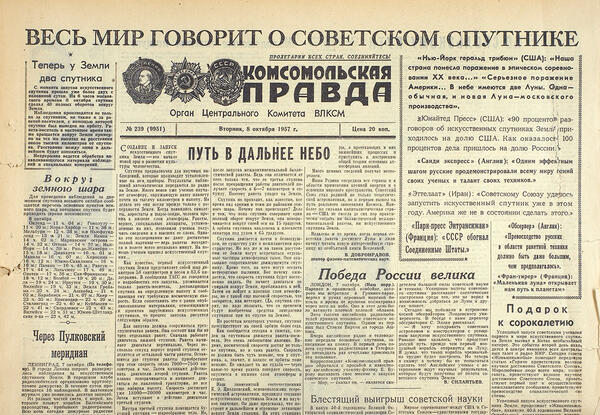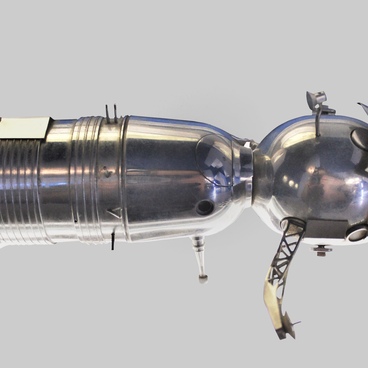On October 4, 1957, a momentous event took place in our country that marked the beginning of a new era in the development of humankind - the space age. The dream of Konstantin Tsiolkovsky to which he dedicated all his life, was realized: mankind took the first step on the way to conquering outer space. The first artificial satellite was launched into Earth orbit. It had a simple name: ‘Sputnik-1’. The code designation of the vehicle is PS-1, which is interpreted as ‘Proto Sputnik-1’.
The satellite was the first artificial celestial body. It was launched from the 5th Research and Development Test Site of the Ministry of Defense of the USSR. Later it became the Baikonur Cosmodrome. As soon as it orbited the Earth for the first time the message of TASS was heard: ‘As a result of sustained, strenuous work of research institutes and design bureaus, the first artificial satellite of the Earth in the world has been created’.
Scientists Mstislav Keldysh, Mikhail Tikhonravov, Nikolai Lidorenko and many other scientists worked on the creation of an artificial satellite of the Earth, headed by the founder of practical cosmonautics Sergey KorolEv. The first satellite was a 58-centimeter ball, weighed 83,6 kilograms, was equipped with four 2point4- and 2point9-metre-long buggy-whip antennas, which transmitted signals from battery-powered transmitters. 50 kg silver-zinc batteries, radio transmitter, a fan, thermostat, pressure and temperature sensors were placed inside the balloon. The satellite was in flight for 92 days and orbited the Earth 1,440 times (which is about 60 million kilometers), and its radio transmitters operated for two weeks after the launch. Due to friction in the upper atmosphere, the satellite lost speed, entered the dense atmosphere and burned away.
The analysis of the signals received from the satellite enabled scientists to study the upper ionosphere, which had not previously been possible. In addition, they obtained useful information on the operation of the instruments, verified all calculations and determined the density of the upper atmosphere by the slowdown of the satellite. All of this was useful for further launches.
In September 1967, the International Astronautical Federation proclaimed the 4th of October as the Day of the Beginning of the Space Age of Mankind.
The prototype of the first artificial satellite of the Earth, presented in the museum, is full-size. This is exactly how the first satellite that humans launched into space looked.
The satellite was the first artificial celestial body. It was launched from the 5th Research and Development Test Site of the Ministry of Defense of the USSR. Later it became the Baikonur Cosmodrome. As soon as it orbited the Earth for the first time the message of TASS was heard: ‘As a result of sustained, strenuous work of research institutes and design bureaus, the first artificial satellite of the Earth in the world has been created’.
Scientists Mstislav Keldysh, Mikhail Tikhonravov, Nikolai Lidorenko and many other scientists worked on the creation of an artificial satellite of the Earth, headed by the founder of practical cosmonautics Sergey KorolEv. The first satellite was a 58-centimeter ball, weighed 83,6 kilograms, was equipped with four 2point4- and 2point9-metre-long buggy-whip antennas, which transmitted signals from battery-powered transmitters. 50 kg silver-zinc batteries, radio transmitter, a fan, thermostat, pressure and temperature sensors were placed inside the balloon. The satellite was in flight for 92 days and orbited the Earth 1,440 times (which is about 60 million kilometers), and its radio transmitters operated for two weeks after the launch. Due to friction in the upper atmosphere, the satellite lost speed, entered the dense atmosphere and burned away.
The analysis of the signals received from the satellite enabled scientists to study the upper ionosphere, which had not previously been possible. In addition, they obtained useful information on the operation of the instruments, verified all calculations and determined the density of the upper atmosphere by the slowdown of the satellite. All of this was useful for further launches.
In September 1967, the International Astronautical Federation proclaimed the 4th of October as the Day of the Beginning of the Space Age of Mankind.
The prototype of the first artificial satellite of the Earth, presented in the museum, is full-size. This is exactly how the first satellite that humans launched into space looked.




